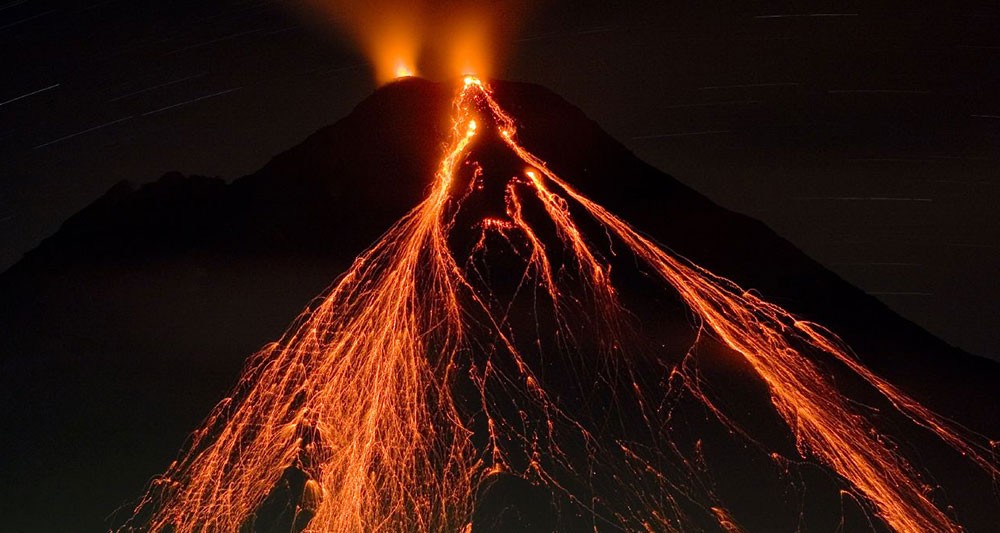
Firestarters: The Hottest Volcanoes in Latin America
Scientists estimate there likely have been millions of active volcanoes throughout our planet’s lifespan, but in recent history there are only about 1,500 known active volcanoes. Of those, 75 percent occur within the Pacific Ring of Fire, and as many as 20 are erupting somewhere on Earth on any given day.
Humbling, awe-inspiring and formidable, volcanos draw more and more visitors every year, as volcano geo-tourism gains in popularity. Whether for the adventure and magic of seeing creation, destruction and the inner workings of Earth or to get an up-close view of the rich biodiversity created by volcanic activity, more than 100 million people visit volcanic and geothermal sites every year.
Central and South America, from Guatemala on down to Argentina, boast their fair share of popular volcanic hotspots with active erupting and active dormant giants capturing traveler’s imaginations and inspiring once-in-a-lifetime excursions to witness firsthand the raw power of Mother Nature. Active volcanoes are those that have erupted at least once in the last 10,000 years. Here are our favorites by country:
ARGENTINA
Ojos del Salado | 22,615 ft.
The highest active volcano in the world, Argentina’s Ojos del Salado hasn’t erupted in more than a thousand years but fumaroles and young lava flows are present. It sits in the Andes on the border with Chile, but access requires less bureaucratic red tape on the Argentinian side. The imposing mountain includes a double summit and permanent crater lake despite its proximity to the Atacama desert but is mostly walkable until near the peak, which is a more technical climb. Depart from Fiambala and be sure to check in with local police, as weather here is unpredictable and prone to fast, dangerous changes. Season: December to March.
BOLIVIA
Parinacota | 20,827 ft.
Situated in Bolivia’s Sajama National Park on the Chilean border, Parinacota is an active behemoth of almost perfect conical shape and symmetry and an almost perfect twin to the neighboring Pomerape (an older dormant volcano located right next door). The mountain’s easy slope, picturesque views of Lake Chungará, abundant hot springs, active fumaroles and young lava flows make the trip quite appealing and the trek relatively easy during season. While it is possible to climb in the off season, snow can make ascent very dangerous and nearly impossible. Season: June to September.
CHILE
Calbuco & Osorno | 6,611 & 8,701 ft.
Iconic as much for the surrounding landscape as for their eruptive activity, Calbuco and Osorno are located in the southern Chilean Andes in the lake district just across Llanquihue Lake from one another. Despite their relatively low elevation, the upper slopes of each are snow covered, and Calbuco even has ice caves with steam near the top. It erupted earlier this year, forcing the closure of the adjacent national reserve and the cancellation of incoming flights to Chile, Argentina and Uruguay. Although mostly re-opened, Calbuco, in particular, is considered very explosive with eruptions shooting ash as high as six miles into the sky. Lava flows occur here. Season: December to March.
Villarrica | 9,380 ft.
One of only a handful of volcanoes worldwide to have an active, but intermittent, lava lake in its crater, Villarrica is one of Chile’s most active erupting volcanoes and has triggered numerous alerts and evacuations just in the last year. The mountain’s upper peaks permanently are covered in glacial snow and, despite its eruptive nature, it is actually available to hike—though we might suggest viewing it via helicopter or from the nearby village in the evening when it casts an orange glow in the night sky. Massive lahars have occurred here and still are possible due to the glacial ice. Season: Year round but peak is January and February.
Easter Island | 6,600 ft.
An honorable mention goes out to this volcanic high island, consisting of three extinct volcanoes and home to a number of smaller craters, cones, caves, lava tubes and cinders. Popular tourist sites on Easter Island include the cinder cone at Puna Pau and the crater at Rano Raraku. Of course, the entire island is a distinct ecological region known primarily for its mysterious moai statues and UNESCO World Heritage status. Look for evidence of the past in lava flow moulds. Season: December to March.
COLOMBIA
Galeras | 14,029 ft.
The only U.N. designated Decade Volcano in South America, Galeras is considered the most active in Colombia and has been the frequent subject of scientific study. It has a violent eruptive history and is in close proximity to the city of Pasto, where roughly a half million people live. Despite a 1993 eruption killing nine people, many residents ignore calls for evacuation due to degassing and pyroclastic flows from the horseshoe shaped caldera of this arresting mountain. It is off limits to hikers, but the surrounding national reserve affords excellent views of one of the most revered volcanoes in Latin America. Season: December to February and June to August.
COSTA RICA
Arenal | 5,358 ft.
Although there has been no major eruption since 2010, Arenal is widely considered to be Costa Rica’s most active with consistent fiery red lava flows— best viewed in the evening in our opinion. It also is the youngest of the Costa Rican volcanoes but also one of the deadliest. An eruption in the 1960s decimated three villages and killed 87 people, giving the town of La Fortuna, which escaped destruction, its new name. There is a dormant collapsed crater lagoon here and the surrounding national park makes for great hiking. Dedicated on-site park rangers close trails deemed unsafe and hikers will see abundant wildlife, including tapir, monkeys, deer, parrots and more. Season: Year round (except September and October). UPDATE: Arenal is NOT CURRENTLY ERUPTING!
Rincon de la Vieja | 6,286 ft.
Renowned for its bubbling mud baths, hot springs and active fumaroles, Rincon de la Vieja is in the remote Guanacaste region, which is known primarily for its beaches. It is an active erupting volcano tucked into a national park with abundant hiking trails where it’s not uncommon to see sloths, tapirs, kinkajous, pumas, jaguar and monkeys (it’s also a birder’s paradise). Prior to the last major eruption in 2011, hiking to the crater was allowed, but the volcano itself has since been closed off to tourists. We highly recommend a visit to this park when in Guanacaste, and encourage a dip in the restorative mud baths after a day’s trek. Season: November to April.
Poas | 8,885 ft.
This is, perhaps, Costa Rica’s most visited national park, so the best time to go is early morning for the best chance to avoid the crowds (and the perpetual cloud cover). The volcano itself is actively erupting, and killed at least 40 people in 2009, but doesn’t spew lava. Instead, eruptions are crater lake geysers that shoot acidic water 800+ feet into the air. The trail to the first (and more well-known) crater is an easy 10 minute walk where you’ll see hummingbirds, flycatchers, toucanets, quetzals and the endemic Poas squirrel. The second crater requires a very steep half mile hike/climb but its otherworldly terrain is well worth it. Both provide a stark glimpse at the unfortunate effects of acid rain on the environment. Season: January to April.
Irazu | 11,260 ft.
From the peak of the highest active erupting volcano in Costa Rica, it’s possible to see both the Caribbean and the Pacific on a clear day. Of course, those optimal conditions are rare and, like most Costa Rican volcanoes, the five craters of this complex volcanic shield generally are covered in rolling clouds. Another of the country’s most popular parks, it is important to get there early to avoid the crowds. The trail up to the summit is roughly a half mile, and there isn’t much wildlife to see due to near constant seismic activity. There is, however, an extensive museum dedicated to volcanoes where you may even see photos of Irazu’s last major eruption, which showered ash and glowing boulders for years in the 1960s. Season: December to April.
ECUADOR
Avenue of the Volcanoes | up to 20,565 ft.
It’s impossible to pick a favorite from among the peaks found along the 200-mile Avenue of the Volcanoes south of Quito in Ecuador. There are seven massive volcanoes of more than 17,000 feet in this chain, with the tallest being Chimborazo at 20,565 feet. Two of the others, Sangay and Tungurahua, are among the most active volcanoes in the entire world. Heading south from Quito to Cotopaxi, which at 19,348 feet is almost as tall as Kilimanjaro, is the beginning of any tour of the Avenue. Snow capped and almost perfectly symmetrical, it often is described as the most beautiful volcano in the world. From there, you’ll head south through charming indigenous villages, across the Devil’s Cauldron Cascade and stopping at hot springs before boarding a 100-year-old train through the staggering Devil’s Nose. Journeys typically end in the UNESCO World Heritage Site of Cuenca but can extend into Guayaquil. Season: December to April.
GUATEMALA
Pacaya | 8,373 ft.
They say it’s the small volcano that just keeps on giving with its nearly continuous mild strombolian eruptions, occasional slow moving lava flows, intermittent lava fountains, cooled lava chambers and broken peak. Despite its relatively small size, Pacaya actually is the largest post caldera volcano in the world and one of Central America’s most active in modern times. It’s proximity to Guatemala City and Antigua makes Pacaya a popular destination, so get there early to avoid the crowds. We have it on good authority that this is not an easy hike no matter what anyone else tells you. It is almost two miles. Pretty much straight up. The reward at the end? A beautiful churning lava lake and, if you time it right, a pretty spectacular sunset. Season: November to April.
Fuego, Acatenango & Agua | 12,346, 13,044 & 12,336 ft.
Although Fuego and Acatenango are part of a larger complex that also includes Pacaya and Agua between Guatemala City and Antigua, these two specifically are known as the pair of La Horqueta. Fuego is pretty much always active (including as recently as last week, which reinvigorated stronger lava flows on the mountain) and spewing smoke from low level eruptions. Acatenango, home to the Three Sisters, is much quieter and the best spot to take in the full majesty of neighboring Fuego (especially at sunrise and sunset) without sweating the lava. Very few people actually hike on Fuego, but it is possible. However, even the safer trek up Acatenango is extremely long and technical. It should be reserved for those in great physical condition. A much easier trail lies opposite the twins at Agua. Noted for its impressive symmetry and regularly described as the “perfect volcano,” Agua is perhaps the most iconic natural landmark in Guatemala. The locals call it Hunapú, which means “place of flowers,” so it shouldn’t be surprising they grow some pretty tasty coffee on its lower slopes. Season: November to April.
Santa Maria & Tajumulco | 12,375 & 13,845 ft.
Located near Quequezaltenango (aka Xela), Santa Maria is home to one of the largest eruptions in modern times, spewing some 1.3 cubic miles of magma and scattering ash as far as San Francisco in 1902. At least 5,000 people were killed in the colossal eruption that blew the side right off the mountain, leaving a half mile wide crater. Today, an active lava dome grows here and is a popular destination for both locals and tourists who climb the mountain daily. Trails are well marked and relatively easy though steep. The top, known as “the dead zone” is barren and rocky but affords a great view of neighboring Santiaguito (an active vent of Santa Maria). Also nearby is the highest mountain in Central America— Tajumulco. Although dormant, it is taller than most of the Rockies and provides a true high alpine experience in Central America for those intrepid travelers who can ensure the challenging trek. Season: November to Apri.
PANAMA
Volcan Baru | 11,398 ft.
Perched on a lahar (volcanic mud or debris flow) not far from the Costa Rican border in the department of Chiriqui is the tallest mountain in Panama— Volcan Baru. On a clear day, it’s possible to see both the Caribbean and Pacific from its striking summit, which is accessible via two trails just outside Boquete. The first wraps around the side of the mountain and takes about six hours, while the second summits the peak and can best be described as challenging and strenuous. Baru is located in a national park where visitors can see more than 250 species of bird and all five of the region’s big cats, as well as an ancient forest through a hole where the mountain has been eroded away by a river. Season: Year round but best from December to April.
PERU
El Misti, Pikchu Pikchu & Chachani | 5,822, 18,583 & 19,872 ft.
All in the Peruvian Andes mountain range near Arequipa and fairly close together, with El Misti standing between Pikchu Pikchu and Chachani, these three volcanoes form an imposing highland landscape of steep inclines, snowcapped peaks and archeological wonders. El Misti is historically explosive and is considered one of the world’s most dangerous volcanoes. It is the only active one of the three and has three craters and a visible inner fumarole. Chachani boasts permanent snow and ice, as well as two lava domes dating to before the last ice age. Pikchu Pikchu is dormant. Hiking all three is possible but does require special equipment like crampons and ice axes. El Misti is considered particularly challenging due to its extremely steep face. Season: July to November.
Ubinas | 18,609 ft.
Located in the Atacama desert, Ubinas is the most active erupting volcano in Peru. All though it technically is possible to hike to the summit of the one mile wide crater and supposedly in it as well, we recommend keeping a bit of distance to this one. The surrounding landscape feels almost lunar, and there is plenty to see without climbing into the mouth of this very active volcano. Season: Year round but you can see pink flamingoes January to August.
Ampato | 20,630 ft.
Another honorable mention goes out to Ampato. Part of the volcanic range that includes Wallqa Wallqa and Sabancaya, this dormant volcano is most famously known as the site where the Ice Maiden was found in 1995. Three additional Inca mummies have been found here since.
If you’re ready to get an up-close look at these awe-inspiring firestarters, call us today to plan your dream journey.
Just remember, this type of adventure travel can be dangerous. You can minimize risk by being physically fit for the type of trail you’re on, going with expert local guides (which we’ll book for you), minding posted signs and warnings and having the right equipment (including helmets and gas masks). In some areas, Guatemala in particular, you’ll also want to watch out for armed robbers and land mines. Local guides are especially important here.
Now get out there and start your adventure!
Comments
No Comments
Leave a Reply:
You must be logged in to post a comment.














